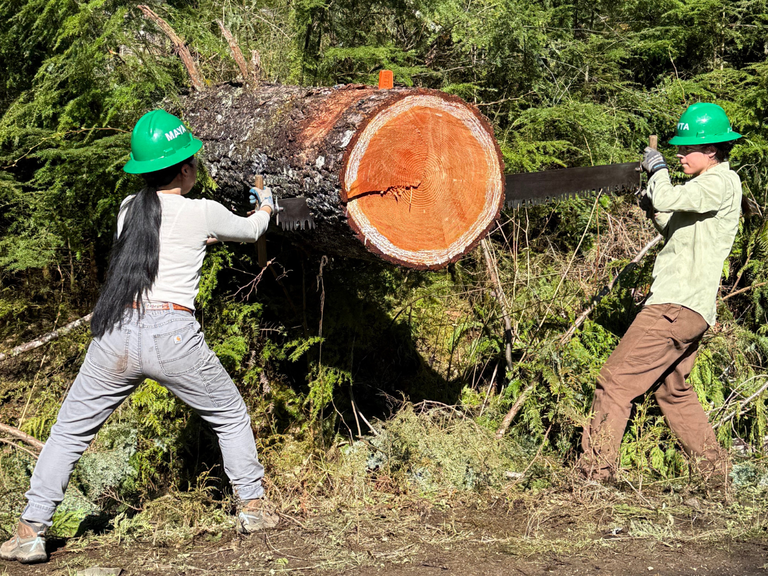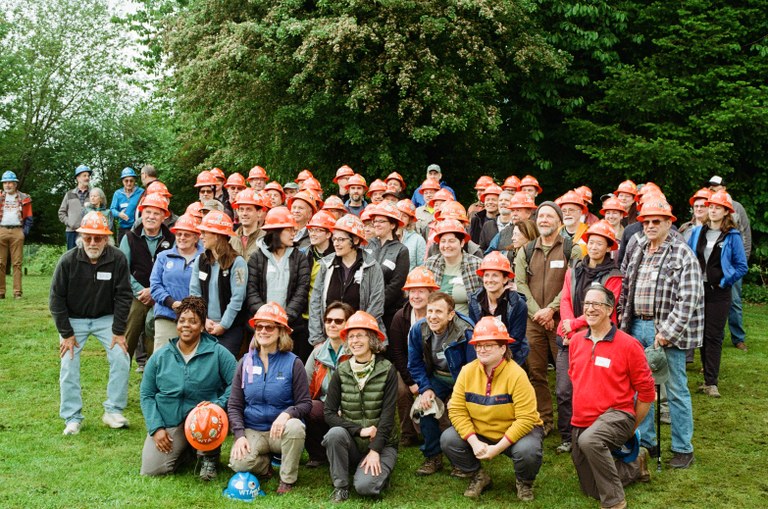 Washington Trails
Association
Washington Trails
Association
Trails for everyone, forever
Cutting timber is a specialty task. Without sawyers, we wouldn't be able to create and maintain trails that last the test of time. That's why WTA's saw program and professional services are being tapped to help train sawyers statewide. By Joseph Gonzalez
Saw·yer (noun): a person who saws timber for a living.
A sawyer is a good person to have on your team if you’re invested in maintaining trails. That’s especially true in Washington, where over 40% of our land is covered in trees. They’re able to use chainsaws and crosscut saws to clear fallen logs and fell dead trees, making trails safer and easier to hike.
Cutting timber is a specialty task, and without these experts, we wouldn’t be able to continue our work to create and maintain trails that stand the test of time. That’s why WTA’s saw program and professional services are being tapped to help train sawyers statewide.
WTA’s sawyer program originally started with the Darrington Ranger District of Mt. Baker-Snoqualmie National Forest. Bridget Wisniewski of the U.S. Forest Service and WTA’s Alan Carter Mortimer were key to setting up agreements for how we would work together.
Over time, we worked with the Forest Service across the state and established safety guidelines that allowed us to train volunteers on how to use a cross cut saw.
More recently, the Forest Service created a national sawyer curriculum to ensure everyone was using the same safety guidelines. That allowed the Forest Service to officially certify training programs from partner groups, such as WTA. WTA has been using this same curriculum ever since.
Emily Snyder, WTA’s Central Puget Sound trails coordinator, is in charge of WTA’s sawyer training program. She started with WTA as a volunteer in 2014. She went on to become a crew leader in the Darrington area before stepping into her current role in 2020. She says that our partners are an important part of our training.

“A benefit to our program is that we get to cross-pollinate with other trail groups: we train and certify each other’s instructors. You need multiple C-level sawyers to create another new C-level sawyer. We don’t have enough C-level sawyers internally to run in our own independent bubble. Trail maintenance programs in USDA Region 6 are collaborative between user groups.”
One example of this is how WTA helps put on the Cispus Collaborative Chainsaw Training each April, an annual training comprised of 60 student and instructor sawyers in partnership with Backcountry Horsemen of Washington, the Pacific Crest Trail Association, the Pacific Northwest Trail Association, Evergreen Mountain Bike Alliance, Orogenesis, the Northwest Motorcycle Association and other partners from across the state.
It’s not uncommon for WTA to share instructors in the field with these partners. C-level sawyers are rare, so a WTA instructor might lend their support at the training of a partner org and vice versa. WTA even shares a tool cache in North Bend with the Forest Service and the North 350 Blades, a regional chapter of Pacific Crest Trail volunteer trail maintainers.

Sawyers from across the state join WTA for the annual Cispus Collaborative Chainsaw Training. Photo by Stasia Honnold
“Because we’re a certified program with the Forest Service, we’re also tasked with helping train and develop other cooperative programs. Right now, we’re partnered with the Pacific Northwest Trail Association and Washington Conservation Corps to help them stand their programs up. It’s all about helping to train their cohorts in how we run our program so they can do the same for their programs,” Emily said.
Before a trail maintainer can wield a saw on trail, first they need to have the appropriate certification for the corresponding project and land they’re operating on.

The crosscut is a saw with a long handle on each end that is operated by two people working in sync. It’s used to clear fallen trees from trails in areas where chainsaws are not allowed or are impractical. Crosscuts are a critical tool when crews clear trails in wilderness areas, where chainsaws (and other motorized equipment) are not allowed. There are three levels of sawyer certification:
Chainsaws can be used in non-wilderness areas, which often includes the first few miles of a Forest Service trail before the wilderness boundary, and on state land, like areas managed by the Department of Natural resources.
But chainsaws take more training than a crosscut. Any volunteer is allowed to use a crosscut, so long as they’re partnered with a class B sawyer. But to use a chainsaw, maintainers must take a 3 day class before even touching the tool, plus must have some crosscut experience as well as wilderness first aid training. The training includes basics about the tool, how to read logs and how to evaluate a project once it’s done.

A sawyer from Evergreen Mountain Bike Alliance practices their skills on a log. Photo by Stasia Honnold
It can take 2-3 years for a sawyer to receive their B level chainsaw certification because there aren’t many opportunities to practice. Most of WTA’s chainsaw work is conducted in late winter and early spring, to help with clearing trails after winter storms. This was especially true between 2024 and 2025 after a bomb cyclone hit the region in November of 2024.
For the last 3 years, WTA has also hosted an affinity-based crosscut training for its Emerging Leaders Program and Black, Indigenous and People of Color (BIPOC) staff and partners. Sawyers from Earthcorps and the Washington Climbers Coalition have joined the training in previous years, and each year’s Emerging Leaders cohort attends. Logging and sawyer communities are historically White, and providing affinity-based trainings allows BIPOC sawyers exposure and easier access to these niche stewardship skills.

Investing in the education of sawyer skills for the Emerging Leaders Program has directly supported sawyer-based careers for cohort members, many of whom have gone on to work in WTA’s trail maintenance program. Since the Emerging Leaders Program’s began in 2021, eight cohort members have done professional trail work for WTA. Four have gone on to lead another year’s iteration of the Emerging Leaders Program cohort and have worked seasonally in leadership positions with WTA’s professional Lost Trails Found crews.
It’s challenging for aspiring sawyers to find programs and experts to further their education. With recent cuts to public lands budgets and staffing, the future of trail maintenance in Washington remains unclear. The need for experienced sawyers with these niche skills is greater than ever. And at a time when the art of the crosscut and other tools required for backcountry trail maintenance are at risk of being forgotten, WTA and its partners are doing their best to provide opportunities for knowledge sharing and relationship building.

Support to WTA enables us to teach crew leaders and assistant crew leaders statewide. Photo by Joe Hall
Land management agencies are critical to the conservation of public lands and trails. These agencies can’t be replaced: but when WTA’s trail maintenance program works in tandem with its partners, everybody learning saw skills becomes a bit sharper. WTA’s well positioned as a partner because of its long working history with the United States Forest Service and the support of readers, members and volunteers like you.
Please consider making a donation to WTA to help support our efforts to build and maintain trails statewide. Your gifts don’t just affect our work this season — they are investments in the long-term state of our forests, trails and lands through WTA’s rich network of like-minded partners.